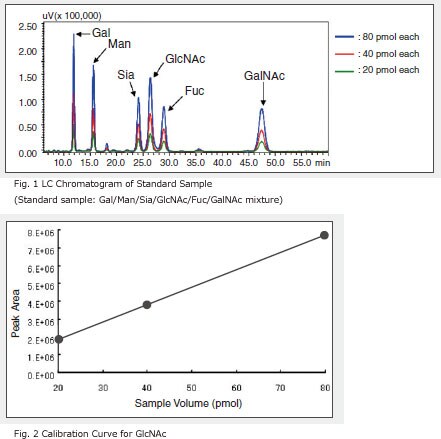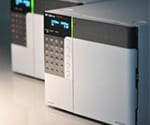Monosaccharide Composition Analysis
As the sugar chains in glycoproteins such as antibody drugs are added by the actions of multiple enzymes after protein translation, the diversity and non-uniformity of the sugar chain structure is an unavoidable problem. The Guidelines require determination of the sugar content (neutral sugars, amino sugars, sialic acid). A differential refractive index detector is generally used for saccharide composition analysis. However, fluorescence detection is used for saccharide composition analysis in antibody drugs as it offers higher sensitivity. As sugars themselves are not fluorescent, they undergo derivatization by an appropriate method to make them fluorescent before analysis by a high-performance liquid chromatograph with a fluorescence detector.
Analysis of Commercial Lab Mouse Monoclonal Antibodies
Experiment and research flow
- Conduct enzyme digestion (neuraminidase, etc.), hydrolysis, and N-acetylation on the mouse monoclonal antibodies.
- Apply fluorescent markers to the reducing terminus of the free monosaccharides using 4-aminobenzoic acid ethylester (ABEE).
- Perform LC analysis of the fluorescent marked monosaccharides using Prominence.
* Use the Plus S ABEE Monosaccharide Composition Analysis Kit (manufactured by J-OIL MILLS, Inc., Japan) for pretreatment of the mouse monoclonal antibodies.

Results
A standard sample comprising a mixture of six monosaccharides with fluorescent markers was analyzed using Prominence, and the calibration curve for each monosaccharide was determined from the area values (Fig. 1 and Fig. 2).
Next, one-tenth of the monosaccharide mixture obtained by treating 60 μg (400 pmol) mouse monoclonal antibody was analyzed using a Prominence system, and the area of each monosaccharide peak was calculated (Fig. 3).
The amount of each monosaccharide contained in 1 mol monoclonal antibody was then calculated from the calculated monosaccharide peak areas, using the calibration curve obtained from the standard sample.
Table 1 lists the amount of each monosaccharide contained per 1 mol of the commercial mouse monoclonal antibody used for this test.




